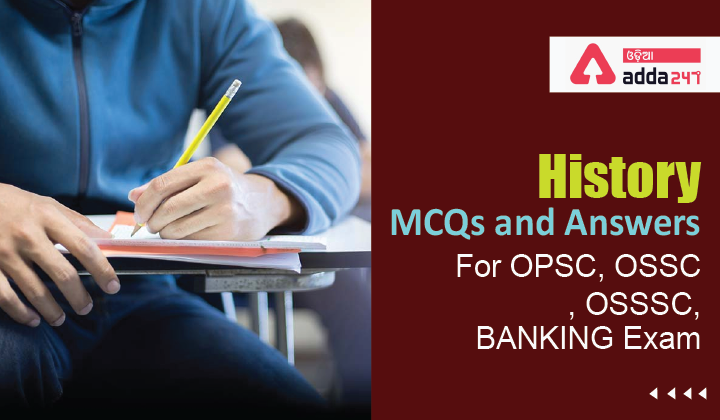History MCQs and Answers: History MCQs are very important for OPSC, OSSC, OSSSC & Other State Exams. Aspirants who are willing to apply for the various Government exams 2022 must go through the topics of History for competitive exams, as History is a key part of the syllabus.
Q1. The basic purpose of the formulation Din-i-Ilahi was:
(a) universal brotherhood
(b) universal faith
(c) universal harmony
(d) universal belief
Q2. Bahadur Shah was the
(a) last ruler of the Lodhi
(b) successor of Sher Shah Suri
(c) last Mughal ruler
(d) successor of the Maratha ruler Shivaji
Q3. The Sultan who described himself as ‘The Second Alexander’ (Sikander-i-Sani) was
(a) Balban
(b) AlauddinKhilji
(c) Muhammad bin Tughluq
(d) Sikander Lodi
Q4. The innovator of the Revenue settlement during the rule of Akbar was
(a) Raja Mansingh
(b) Raja Bhagwan Das
(c) Raja Todarmal
(d) Raja Birbal
Q5. The Grand Trunk Road was built during the reign of which ruler?
(a) Shershah Suri
(b) Babar
(c) Shah Jahan
(d) Akbar
Q6. Name the king who invaded Delhi and plundered the Kohinoor Diamond.
(a) Nadir Shah
(b) Firuz Shah
(c) Mohammed Shah
(d) Mohammed Ghori
Q7. Razia Sultan, the first woman to sit on the throne of Delhi, was the daughter of Sultan
(a) Mohammed Ghori
(b) Mohammed of Ghazni
(c) Iltutmish
(d) AlauddinKhilji
Q8. ‘Prithvirajraso’ was written by
(a) Bhavabhuti
(b) Jaideva
(c) Chand Bardai
(d) Banabhatta
Q9. Where is GolGumbaz, one of the largest dome in the world, situated?
(a) Damascus
(b) Istanbul
(c) Cairo
(d) Bijapur
Q10. The remains of the Great Vijayanagar Empire can be found in
(a) Bijapur
(b) Golconda
(c) Hampi
(d) Baroda
Solutions
S1. Ans.(b)
Sol. Din-iIlahi “the religion of God,” was a system of religious beliefs proposed by the Mughal emperor Akbar in 1582 CE. The idea was to combine Islam and Hinduism into one faith, but also to add aspects of Christianity, Zoroastrianism and Jainism — the latter an ancient Indian creed which emphasized non-violence and vegetarianism.
S2. Ans.(c)
Sol. Mirza Abu Zafar Sirajuddin Muhammad Bahadur Shah Zafar was the last Mughal emperor. He was the second son of and became the successor to his father, Akbar II, upon his death on 28 September 1837.
S3. Ans.(b)
Sol.AlauddinKhilji was a militarist and imperialist to the core. He was very ambitious. Alauddin, whose original name was Ali Gurshap, assumed the title Sikandar-i-Sani (Alexander the Second) and proclaimed Delhi as Dar-ul-Khilafa (Seat of the Caliphate).
S4. Ans.(c)
Sol.RajaTodar Mal was a warrior, an able administrator and an exemplary finance minister. He was one of the ‘Navratnas’ of Akbar’s court. He introduced an excellent land revenue system. In 1582, the title Diwan-I- Ashraf was bestowed upon him by the Emperor.
S5. Ans.(a)
Sol.The route spanning the Grand Trunk (GT) road existed during the reign of Chandragupta Maurya, extending from the mouth of the Ganges to the north-western frontier of the Empire. The predecessor of the modern road was rebuilt by Sher Shah Suri, who renovated and extended the ancient Mauryan route in the 16th century.
S6. Ans.(a)
Sol.Aurangzeb’s death had created a void in the Mughal empire which none of his successors were able to fill. Frequent struggles for throne and betrayal of ministers had resulted in the weakening of the empire. Nadir Shah, who from being a chief of dacoits had become the king of Persia, saw the weak empire as an opportunity. In 1738, Nadir Shah proceeded to invade India.
S7. Ans.(c)
Sol.The fifth Mamluk dynasty ruler, history deems Razia Sultan as one of the very few female rulers in the history of Islamic civilizations across the world.During her reign, she ordered coins be minted with her title as “Pillar of Women, Queen of the Times, Sultan Razia, daughter of ShamsuddinIltumish.”
S8. Ans.(c)
Sol.ThePrithvirajRaso is a Brajbhasha epic poem about the life of the 12th century Indian king Prithviraj Chauhan (c. 1166-1192 CE). It is attributed to Chand Bardai, who according to the text, was a court poet of the king.
S9. Ans.(d)
Sol.Constructed as per the Deccan architecture, GolGumbaz is the most important landmark of Bijapur, Karnataka.
S10. Ans.(c)
Sol.TheVijayanagara Empire (also called Karnata Empire, and the Kingdom of Bisnegar by the Portuguese) was based in the Deccan Plateau region in South India. It was established in 1336 by Harihara I and his brother Bukka Raya I of Sangama Dynasty. The empire’s legacy includes many monuments spread over South India, the best known of which is the group at Hampi.








